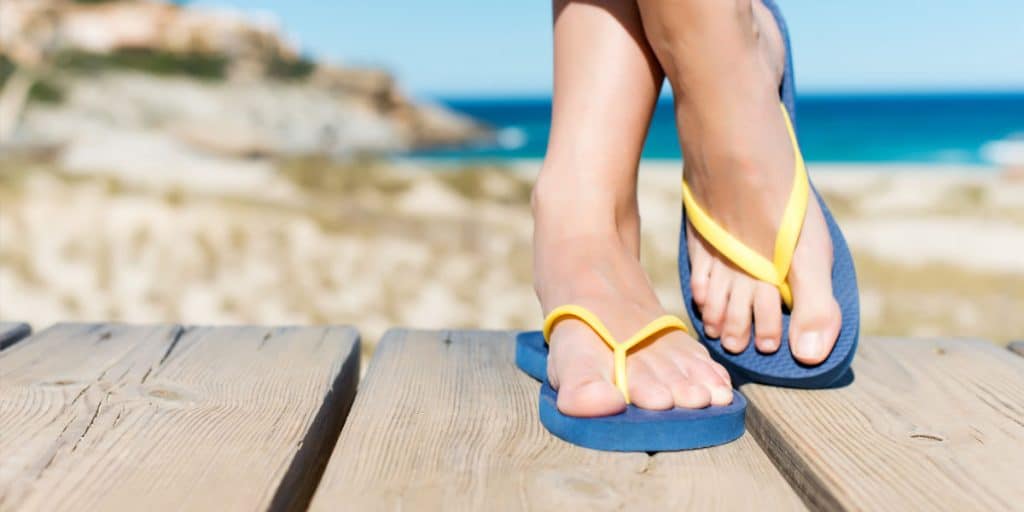Who doesn’t love flip-flops? They come in a rainbow of fun colors and designs. They’re cheap, easy to slip on, and perfect for summer lounging.
But watch your step, beach baby! Your flip-flops could cause foot pain, ankle sprains, and even stress fractures!
Read on for some hot tips for wearing your flips!

Flip flops offer no foot support
Take a good look at your flip-flops. They’re made out of virtually nothing. Most flip-flops, especially the cheaper ones, are essentially a flat piece of rubber and a thong squeezed between your toes.
They have no cushioning, arch support, or outer covering to protect your feet. Flip flops leave your feet exposed to sticks, gravel, hot sand, sharp rocks, and sunburn. Your feet can easily get cut or bruised with nothing to protect them.
The skin on your feet, usually protected by socks and shoes, is more susceptible to sunburns than other tougher areas of your body. And the friction caused by the toe strap can irritate the skin and cause painful, ugly blisters.
Why do my feet hurt when I wear flip-flops?
You might think that flip-flops are “easier” to wear just because you can step right into them, but in reality, your foot has to work a lot harder while walking. Ever notice how your toes involuntarily curl up as you’re walking in flops? Your muscles are straining to keep the shoes on your feet. This could create a muscle imbalance in your foot, possibly causing bunions or hammertoes.
That flat piece of rubber that makes the bottom of the “shoe”? The lack of arch support and shock absorption means it’s not supporting your foot at all, and you’re overworking your foot’s tendons and ligaments.
While wearing flip-flops you can easily develop an overuse injury, such as shin splints, Achilles tendonitis, or plantar fasciitis, and have to spend your summer off your feet. Over time the repeated impact of your foot with the hard ground can even result in heel bone fractures.
I’m sure many of us would love to lie around in a lounge chair and sip margaritas all summer, but these foot problems conditions are definitely not the relaxing vacation you’re looking for.
Or call us at: (855) 829-7821
Is it possible to wear flip-flops safely?
If you simply must wear flip-flops, there are some ways you can minimize your risk of injury.
The first way to protect your feet is to only wear flip-flops for short periods of time, such as walking around the pool deck or using a public shower. They work well for protecting the bottom of your feet from hot concrete and fungal infections.
When buying flip-flops, make sure they properly fit your feet (no part of your foot should hang off the edge of the shoe) and are high-quality. A high-quality flip-flop made of supportive material, ideally with foot and heel straps to hold your foot in place (so basically a sandal).
Here’s an easy little test: If you can bend the sole of the flip-flop in half, guess what? It’s probably not going to do any favors for your foot.
What should I wear instead of flip-flops?
While sand in your sneakers is probably one of the worst feelings ever, painful foot conditions caused by being a chronic flip-flop-wearer are arguably worse.
Instead of flip-flops, you should be wearing a well-fitted supportive shoe with proper arch support, shock absorption, and heel cushioning. Your day-to-day shoe should also fully enclose your foot.
If you’re already experiencing heel pain, arch pain, or ball of the foot pain, it’s extra important that you take a break from wearing flip-flops and switch to a supportive shoe to prevent serious injury.
Why choose University Foot & Ankle Institute for your foot care?
The podiatry specialists at University Foot & Ankle Institute are experts in the biomechanics of the foot and ankle. With a wide range of treatment options for all foot and ankle conditions, our podiatrists can treat foot pain, restore functionality, and improve your overall wellness.
UFAI’s specialties include bunion treatment, plantar fascia pain, Achilles tendinitis, high-quality custom-made orthotics, and orthopedic surgery, to name just a few.
For a consultation, please call (877) 736-6001 or make an appointment online now.
University Foot and Ankle Institute is conveniently located throughout Southern California and the Los Angeles area. Our foot and ankle surgeons are available at locations in or near Santa Monica, Beverly Hills, West Los Angeles, Sherman Oaks, the San Fernando Valley, El Segundo, the South Bay, LAX, Calabasas, Agoura Hills, Westlake Village, Valencia, Santa Clarita, and Santa Barbara.
- Flip-flops Causing You Pain? Protect Your Feet This Summer! - April 23, 2024
- 9 Running Tips from Sports Medicine Experts - November 8, 2023
- Common Foot Problems In Aging Feet: What To Watch Out For - October 16, 2023